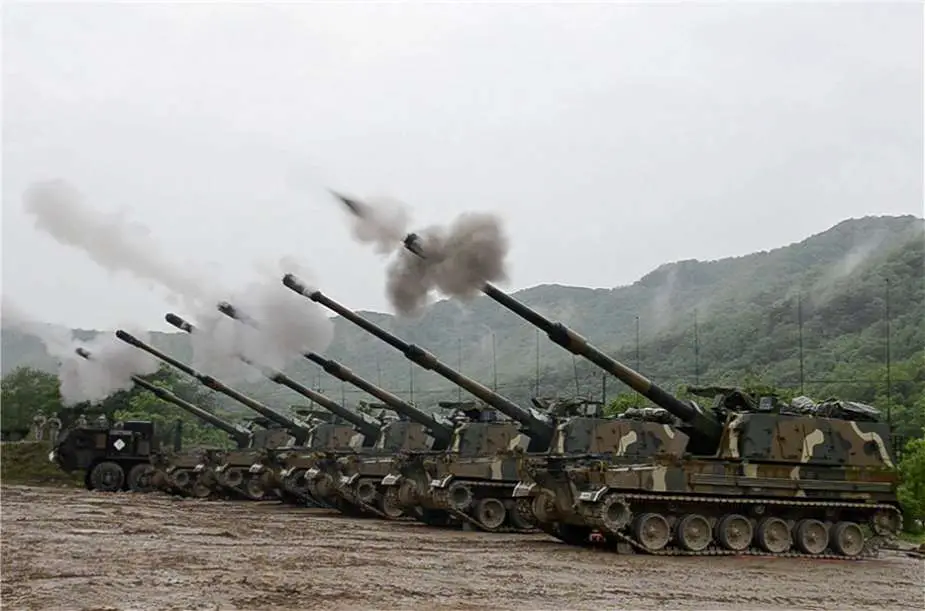On April 17, 2024, the South Korean Yonhap News Agency reported that the South Korean Army and Marine Corps conducted live-fire artillery exercises near the North Korean border to strengthen their defensive capabilities. The drills took place in Cheorwon, located 85 kilometers northeast of Seoul, involving approximately 430 soldiers from the South Korean Army's Capital Corps and the 2nd Marine Division.
Follow Army Recognition on Google News at this link

Archive image: South Korean Soldiers in the 631st Field Artillery Battalion, 26th Mechanized Infantry Division Artillery, coordinate fires from a battery of six K9 Thunder 155 mm self-propelled howitzers. (Picture source U.S. DoD)
During the exercise, 30 artillery systems including K9 and K55A1 self-propelled howitzers were deployed by South Korean armed forces along with counter-battery radars and surveillance drones. The primary objective of the drills, according to South Korean Army officials, was to enhance the operational coordination between the South Korean Army and Marine Corps to more effectively counteract North Korean military provocations.
The K9 Thunder, developed by South Korea, is a highly advanced self-propelled howitzer that serves as a core component of the South Korean Army's artillery units. Designed to meet the demands of modern warfare, the K9 boasts a 155mm/52-caliber gun with a maximum firing range of approximately 40 kilometers using standard ammunition and over 50 kilometers with rocket-assisted projectiles. It features automatic loading capabilities and advanced fire control systems, allowing for rapid response and high accuracy.
The K55A1 is an upgraded version of the South Korean Army's older K55 self-propelled howitzer, which is based on the American M109 howitzer. The K55A1 enhancements were part of a modernization effort to extend the operational life and improve the capabilities of the existing artillery systems. This upgrade includes improved fire control systems, better communication equipment, and advanced navigation systems. The K55A1 is equipped with a 155mm howitzer capable of firing a range of munitions, including standard and rocket-assisted projectiles. These upgrades allow for more accurate targeting and faster response times, crucial for effective artillery support in dynamic combat environments.
This military action follows a significant artillery exercise conducted by North Korea in early March 2024, approximately 40 to 50 kilometers away from the border with North Korea, underscoring the ongoing tensions and preparedness measures in the region.
Recent assessments of North Korea's artillery capabilities highlight its significant conventional firepower, which poses a substantial threat particularly to South Korea due to the proximity and density of civilian populations near the border. North Korea maintains nearly 6,000 artillery systems capable of hitting major South Korean cities like Seoul in a very short amount of time, potentially causing massive casualties.
According to the Military Balance 2023, North Korea possesses a total of approximately 21,600 artillery systems. This includes 8,600 self-propelled howitzers and towed guns, 5,500 Multiple Launch Rocket Systems (MLRS) in various calibers, and 7,500 mortars ranging from 82 to 160 mm. Meanwhile, the South Korean army has a total of 12,120 artillery weapons, which include 2,330 self-propelled howitzers, 3,500 towed guns, 298 MLRSs, and 6,000 mortars ranging from 81 to 120 mm.
In terms of specific artillery types, North Korea operates various large-caliber artillery systems including the 170-mm Koksan gun, which can reach distances up to 60 km (37 miles). They also have multiple launch rocket systems (MLRS) such as the 240-mm and 300-mm diameter systems and the KN-09 rocket artillery, which is the newest in their arsenal with a reported range of 190 to 200 km (118 to 124 miles).
The strategic importance of these artillery capabilities is underscored by their potential use in scenarios ranging from deterrence and coercion to outright military aggression. The density of these systems along the Korean Demilitarized Zone (DMZ) means that North Korea can launch a barrage of artillery fire with little to no warning, creating a severe immediate threat to South Korea.
Maintaining robust artillery capabilities is crucial for the South Korean army primarily as a deterrent against North Korean aggression. The proximity of the heavily militarized Demilitarized Zone (DMZ) to major South Korean metropolitan areas, such as Seoul, necessitates a strong and ready military response capability. Artillery units like the K9 and K55A1 howitzers provide rapid, high-volume fire support, which is vital in the early stages of conflict to suppress enemy advances and protect civilian areas.
Defense News April 2024
















